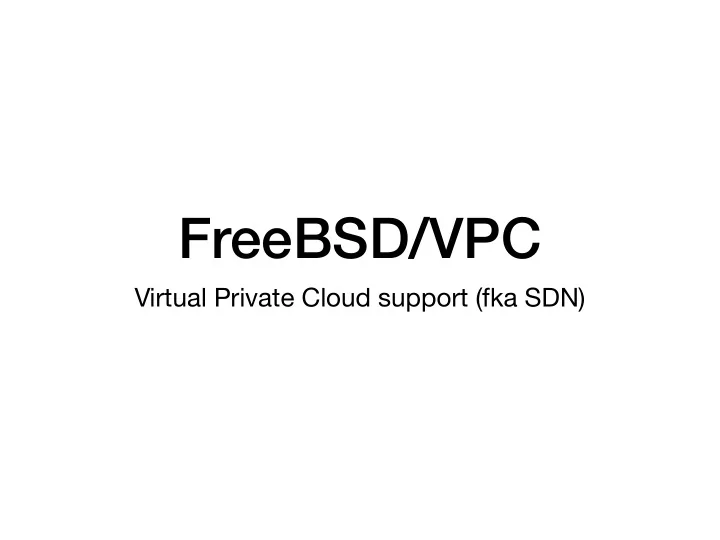

FreeBSD/VPC Virtual Private Cloud support (fka SDN)
Virtualization Status • bhyve(4) is a stable, performant hypervisor • Network isolation is not core to bhyve(4) today • Use of VNET(9) for manipulating FIBS for tap(4) interfaces is possible, but limited and not performant
Problem • bhyve(4) guests run customer workloads • Cloud providers need a single FIB for the underlay network • Guests run in isolated overlay networks • How do you map guests to their respective overlay network?
Guest Workloads Guest 1 Guest 2 Customer A Customer B em0
Guest Workloads Guest 1 Guest 2 Guest 3 Customer A Customer B Customer B tap51 tap52 bridge0 em0
FreeBSD • bhyve(4) guests run customer workloads • Cloud providers need a single FIB for the underlay network • Guests run in isolated overlay networks • How do you map guests to their respective overlay network?
if_bridge(4) Approach Guest 1 Guest 2 Guest 3 Customer A Customer B Customer B tap50 tap51 tap52 bridge1 bridge2 bridge0 em0
Problems with Current Tools: tap(4) / bridge(4) / vxlan(4) / VNET(9) • tap(4) is slow • bridge(4) is slow • vxlan(4) sends received packets through ip_input() twice (i.e. "sub-optimal") • VNET(9) virtualizes underlay networks, not overlay networks • How do you ARP across machines? • How do you perform vxlan(4) encap?
FreeBSD/vpc Guest 1 Guest 2 Guest 3 Customer A Customer B Customer B vmnic0 vmnic1 vmnic2 vpcsw0 vpcsw1 vpclink0 em0
FreeBSD/vpc Multi-Host Guest 1 Guest 2 Guest 3 Customer A Customer B Customer B vmnic0 vmnic1 vmnic2 vpcsw0 vpcsw1 vpclink0 em0 ??? em0 vpclink0 vpcsw0 vpcsw1 vmnic1 vmnic0 vmnic2 Guest 1 Guest 2 Guest 3 Customer A Customer B Customer B
FreeBSD/vpc Multi-Host Guest 1 Guest 2 Guest 3 Customer A Customer B Customer B vmnic0 vmnic1 vmnic2 vpcsw0 vpcsw1 VNI 987 VNI 123 vpclink0 em0 VXLAN Packets em0 VNI 123 VNI 987 vpclink0 vpcsw0 vpcsw1 vmnic1 vmnic0 vmnic2 Guest 1 Guest 2 Guest 3 Customer A Customer B Customer B
VXLAN to the Rescue • Encapsulates all IP packets as UDP • Adds a preamble to IP packet • Tags packets and with a VXLAN ID, known as a VNI • VXLAN is similar to VLAN tagging, but embeds tagging in the IP header, not in the L2 frame
FreeBSD/vpc Multi-Host Guest 1 Guest 2 Guest 3 Customer A Customer B Customer B vmnic0 vmnic1 vmnic2 vpcsw0 vpcsw1 VNI 987 VNI 123 vpclink0 em0 VXLAN Packets em0 VNI 123 VNI 987 vpclink0 vpcsw0 vpcsw1 vmnic1 vmnic0 vmnic2 Guest 1 Guest 2 Guest 3 Customer A Customer B Customer B
vpc(4) Interfaces • vpcsw(4) - switches packets - one packet per customer, multiple subnets supported in the same switch • vmnic(4) - dedicated guest NIC, looks like a virtio network device to guests • vpcp(4) - plugs vmnic(4) ports into vpcsw(4) switches • vpci(4) - Non- bhyve(4) interface, usable in jails(2) • ethlink(4) - Performs unencapsulated packet forwarding, wraps a cloned or physical ethernet interface • vpclink(4) - Performs VXLAN encapsulation
New System Calls • vpc_open(2) - Creates a new VPC descriptor • vpc_ctl(2) - Manipulates VPC descriptors • Capsicum-like, intended for privilege separation • Intended for idempotent tooling • Makes aggressive use of UUIDs as operator handles to be compatible with Triton
Ongoing Work • Firewalling • Routing • NAT • Userland Control Plane (including setup and teardown of bhyve(4) guests via something not a shell script)
Code • Kernel: https://github.com/joyent/freebsd/tree/projects/VPC • Kernel Libraries: https://github.com/joyent/freebsd/tree/projects/VPC/ libexec/go/src/go.freebsd.org/sys/vpc • Userland tooling: https://github.com/sean-/vpc
Questions?
Recommend
More recommend